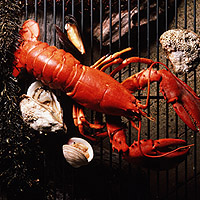Gluten Free
What does following a gluten-free diet mean? That you're embarking on an easy diet with a wide range of health-promoting effects. Instead of dwelling on what you’re giving up, consider that you’re going to enjoy a whole new world of delicious food options to meet your special dietary needs. You’ll be eating seasonally, choosing more fresh fruits and vegetables, focusing on meats, seafood, poultry, legumes, lentils, corn, and rice, and discovering fascinating ancient grains such as quinoa, amaranth, and millet. You’ll be able to eat potatoes, eggs, most cheeses, even chocolate (!)—and enjoy them without guilt because you’ll be taking good care of your body. In fact, you’ll probably end up eating—and feeling—better than ever!
Visit this page for more information about living Gluten Free
---
We carry a large variety of gluten free items, the brands listed below represent just some of the offerings we carry















More Diets
Lobster

Preparation, Uses, & Tips
Lobster can be cooked like crab, in boiling water. For a quicker, more humane method, stab the head just behind the eyes, bringing the knife through to the cutting board, then pressing it forward to divide the head.
To prepare for boiling, kill the lobster and split it lengthwise. Remove the stomach sac and pull out the intestinal vein. Scoop out the tomalley and roe, and rinse under cold water. To prepare frozen lobster tail, defrost, then cut the inner edges of the under-shell with a pair of scissors. Clip off the fins, pull back the shell and discard. Bend the tail back to crack the joints. Rinse with cold water.
Boiling
Fill a large pan with at least 1 gallon (3.79 liters) of water plus another quart for each additional lobster and bring to a rapid boil. One at a time, plunge live or prepared lobsters headfirst into boiling water. Reduce heat and simmer five minutes for a 1 1/4 pound (about 567g) lobster plus two minutes for each additional pound (about 454g).
Broiling
Place whole, cooked lobster (or lobster tail) meat-side-up in a broiler pan. Brush with lemon and oil or melted butter. Place 4 inches (10cm) from heating element or flame and broil until meat is heated through. Follow the same method to cook raw lobster tails, except broil tail-side-up for four minutes, then turn, brush with butter or oil, and broil until meat is opaque (four to five minutes).
Baking
Kill the lobster, split it lengthwise, and remove the sand-colored grain sac from each side of its head. Twist off claws. Heat oven to 400°F (200° C). Place claws on a shallow baking pan and cook about eight minutes. Remove pan from the oven, then add lobster halves flesh side up. Brush with lemon juice and oil or melted butter and cook for an additional ten minutes.
Steaming
Place an inch or two (about 2.5 to 5cm) of water in a large pot and bring to a boil. Put the whole, live lobsters (or kill them first by splitting the head) in the pot and steam for about five minutes. Use the cooking liquid as base for a sauce.
Soups or stews
Boil lobster lightly—the meat should not be fully cooked. When cool, crack shells and remove meat, tomalley, and coral. Break up shells with a hammer and boil them in water to form a savory broth. Strain the broth to remove shells, then add herbs, spices, and vegetables. Add lobster meat during the final few minutes of cooking.
Copyright © 2025 TraceGains, Inc. All rights reserved.
Learn more about TraceGains, the company.
The information presented in the Food Guide is for informational purposes only and was created by a team of US–registered dietitians and food experts. Consult your doctor, practitioner, and/or pharmacist for any health problem and before using any supplements, making dietary changes, or before making any changes in prescribed medications. Information expires December 2025.











